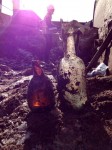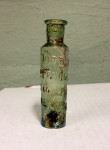 During an archaeological survey before construction of a new hotel at 50 Bowery in New York City, archaeologists unearthed a trove of 19th century bottles from when the space was occupied by a German beer garden. Atlantic Gardens offered beer and live entertainment from 1858 until it closed in 1916, leaving behind all kinds of dishes and bottles. Among the latter were bottles of patent medicine, nostrums made from combinations of herbs and alcohol or even narcotics like opium, that claimed to cure a wide variety of ailments.
During an archaeological survey before construction of a new hotel at 50 Bowery in New York City, archaeologists unearthed a trove of 19th century bottles from when the space was occupied by a German beer garden. Atlantic Gardens offered beer and live entertainment from 1858 until it closed in 1916, leaving behind all kinds of dishes and bottles. Among the latter were bottles of patent medicine, nostrums made from combinations of herbs and alcohol or even narcotics like opium, that claimed to cure a wide variety of ailments.
One of the bottles was a small green glass cylinder labeled “Elixir of Long Life.” Two bottles of Dr. Hostetters Stomach Bitters were also discovered at the site. With the empty vessels in hand, the experts of contractor Chrysalis Archaeology decided to seek out recipes and recreate the products that once sold briskly at taverns as well as at apothecary shops and from street vendors.
 After researching the brands in German, the team found that The Elixir of Long Life is a fairly straight-forward collection of ingredients from the herbalist handbook — aloe, an anti-inflammatory, gentian root, a digestive aid — combined with lots of alcohol. Dr. Hostetters Stomach Bitters went a bit further afield:
After researching the brands in German, the team found that The Elixir of Long Life is a fairly straight-forward collection of ingredients from the herbalist handbook — aloe, an anti-inflammatory, gentian root, a digestive aid — combined with lots of alcohol. Dr. Hostetters Stomach Bitters went a bit further afield:
The Hostetters recipe is a bit more complex, containing Peruvian bark, also known as cinchona, which is used for its malaria-fighting properties and is still used to make bitters for cocktails, and gum kino, a kind of tree sap that is antibacterial. It also contains more common ingredients, including cinnamon and cardamom seeds, which are known to help prevent gas.
 But it too was proportionally dominated by grain alcohol, so even if the herbs didn’t cure what ailed you, the rest of it would make you forget about how sick you were. In fact, although Dr. Hostetters bitters may not be sold as medicines anymore, its cousins like Angostura and Aperol are popular ingredients in cocktails and are often consumed before or after meals because they’re still considered digestive boosts, a hangover from their days of being sold at taverns to quell the stomach demons.
But it too was proportionally dominated by grain alcohol, so even if the herbs didn’t cure what ailed you, the rest of it would make you forget about how sick you were. In fact, although Dr. Hostetters bitters may not be sold as medicines anymore, its cousins like Angostura and Aperol are popular ingredients in cocktails and are often consumed before or after meals because they’re still considered digestive boosts, a hangover from their days of being sold at taverns to quell the stomach demons.
But why should the archaeologists have all the fun? Here are the recipes to make your own Elixir of Long Life and Dr. Hostetters Stomach Bitters in the comfort of your own home.
Elixir of Long Life:
Aloes – 13 grams
Rhubarb – 2.3 grams
Gentian – 2.3 grams
Zedoary (white turmeric) – 2.3 grams
Spanish saffron – 2.3 grams
Water – 4 ounces
Grain alcohol (vodka, gin) – 12 ouncesSqueeze out the liquid from the aloe and set aside. Crush the rhubarb, gentian, zedoary and Spanish saffron (for a modern twist, use a blender for this part), and mix them with the aloe liquid, water and alcohol. Let the mixture sit for three days, shaking frequently. Then filter it using a cheesecloth or coffee filter, and serve. Be careful with the liquid — the saffron can dye your hands or other kitchen items.
Dr. Hostetters Stomach Bitters:
Gentian root – 1 1/2 ounces
Orange peel – 2 1/2 ounces
Cinnamon – 1/4 ounce
Anise – 1/2 ounces
Coriander seed – 1/2 ounce
Cardamom seed – 1/8 ounce
Un-ground Peruvian bark (cinchona) – 1/2 ounce
Gum kino – 1/4 ounce
Grain alcohol (vodka, gin) – 1 quart
Water – 4 quarts
Sugar – 1 poundMash together the gentian, orange peel, cinnamon, anise, coriander, cardamom and Peruvian bark. Mix the crushed ingredients with the gum kino and the alcohol. Let the mixture sit in a closed container for two weeks, shaking occasionally. Strain the mixture, add the sugar and water to the strained liquid and serve.
One of our teachers gave probes of hard spirits that he had produced in his spare time to us teenagers.
After the first sips he explained the diference between ethanol and the dangers of the initial methanol.
With his little speech impediment he warned that ‘with methanol you will go terminally blind’. Well, to make a long story short, since then I know that just ‘alcohol’ won’t do the trick.
:angry: :p
On old bottles: I found a good number of old glass medicine bottles inside the wall of a house I was rehabbing in Ahtabula Ohio’s historic harbor area. They were of the 3-4 oz size, glass toppers, all had a bit of string around the neck. I found one with a long string attached, enough to reach the attic of the house. It would seem that someone was keeping their ‘stash’ down the wall. The bottles had labels dating from around 1900, procured from a pharmacy less than a half mile from the house.
Abuse and the social stigma of drug abuse is nothing new.
“a hangover from their days of being sold at taverns”
I see what you did there! :giggle:
Those are good recipes with real medicinal value. Nostrums like these were taken a spoonful at a time, or given as drops in water. Grain alcohol is simply the best way to extract and preserve the active ingredients. Similar medicines are used today, even by allopathic doctors.
Now it is true that there were (and are)plenty of “snake-oil” salesmen, whose products were little more than flavored distilled alcohol (and you did have to beware of methyl– today we call it rubbing alcohol or solvent alcohol or fuel alcohol). Snake-oil and its variants were scams, but recognized as a handy substitute for drinking alcohol among those with a need to disguise a drinking problem. Many jokes persist about that. But it does not mean that herbal based medicines themselves were fraudulent. Germany has a long, distinguished history of investigating, developing and testing herbal treatments, which is still the case. The US is just beginning to get a handle on this, and often must rely on German research as well as other overseas research in order to avoid comtemporary snake-oil operations seeking to exploit the growing interest in herbals, which now are increasingly by used in conjunction with “standard” medicine.
I was just wondering what the little green bottle was worth for insurance porpoises.